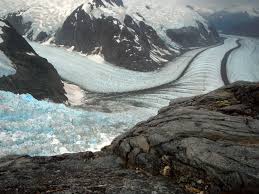Stamp: Ushuaia, Tierra del Fuego (Argentina 2009)
Ushuaia, Tierra del Fuego (Argentina 2009)
01 January (Argentina ) within release UP - Tourist Attractions goes into circulation Stamp Ushuaia, Tierra del Fuego face value 10 Argentine peso
| Stamp Ushuaia, Tierra del Fuego in catalogues | |
|---|---|
| Gz (Cefiloza): | Gz: AR 3126Da |
Stamp is horizontal format.
Security mark at right. Under UV lamp: front neutral, back dark violet. Gum diagonally ribbedAlso in the issue UP - Tourist Attractions:
- Stamp - Mina Clavero, Cordoba face value 4;
- Stamp - Mina Clavero, Cordoba face value 4;
- Stamp - Mina Clavero, Cordoba face value 4;
- Stamp - Ushuaia, Tierra del Fuego face value 10;
- Stamp - Mina Clavero, Cordoba face value 4;
Stamp Ushuaia, Tierra del Fuego it reflects the thematic directions:
A glacier (US: /ˈɡleɪʃər/; UK: /ˈɡlæsiər, ˈɡleɪsiər/) is a persistent body of dense ice that is constantly moving under its own weight. A glacier forms where the accumulation of snow exceeds its ablation over many years, often centuries. It acquires distinguishing features, such as crevasses and seracs, as it slowly flows and deforms under stresses induced by its weight. As it moves, it abrades rock and debris from its substrate to create landforms such as cirques, moraines, or fjords. Although a glacier may flow into a body of water, it forms only on land and is distinct from the much thinner sea ice and lake ice that form on the surface of bodies of water.
A landscape is the visible features of an area of land, its landforms and how they integrate with natural or man-made features. A landscape includes the physical elements of geophysically defined landforms such as (ice-capped) mountains, hills, water bodies such as rivers, lakes, ponds and the sea, living elements of land cover including indigenous vegetation, human elements including different forms of land use, buildings and structures, and transitory elements such as lighting and weather conditions. Combining both their physical origins and the cultural overlay of human presence, often created over millennia, landscapes reflect a living synthesis of people and place that is vital to local and national identity. The character of a landscape helps define the self-image of the people who inhabit it and a sense of place that differentiates one region from other regions. It is the dynamic backdrop to people’s lives. Landscape can be as varied as farmland, a landscape park, or wilderness. The earth has a vast range of landscapes, including the icy landscapes of polar regions, mountainous landscapes, vast arid desert landscapes, islands and coastal landscapes, densely forested or wooded landscapes including past boreal forests and tropical rainforests, and agricultural landscapes of temperate and tropical regions.
Tourism is travel for pleasure or business; also the theory and practice of touring, the business of attracting, accommodating, and entertaining tourists, and the business of operating tours. Tourism may be international, or within the traveller's country. The World Tourism Organization defines tourism more generally, in terms which go "beyond the common perception of tourism as being limited to holiday activity only", as people "traveling to and staying in places outside their usual environment for not more than one consecutive year for leisure, business and other purposes". Tourism can be domestic or international, and international tourism has both incoming and outgoing implications on a country's balance of payments. Today, tourism is a major source of income for many countries, and affects the economy of both the source and host countries, in some cases being of vital importance.
The United Nations Educational, Scientific and Cultural Organization (UNESCO; pronounced /juːˈnɛskoʊ/) is a specialized agency of the United Nations (UN) with the aim of promoting world peace and security through international cooperation in education, arts, sciences and culture. It has 194 member states and 12 associate members,as well as partners in the non-governmental, intergovernmental and private sector. Headquartered in Paris, France, UNESCO has 53 regional field offices and 199 national commissions




